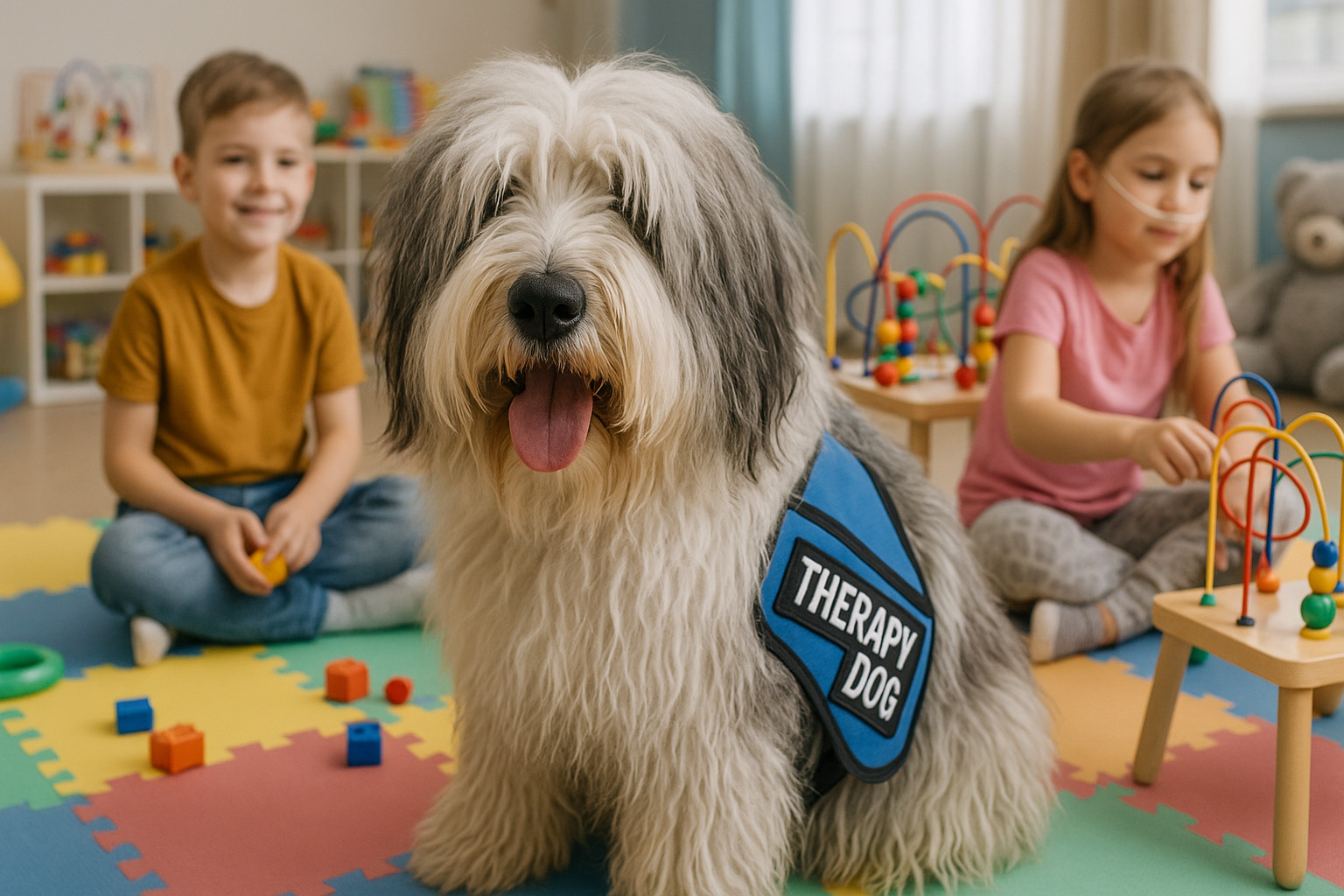Polish Lowland Sheepdog as a Therapy Dog
Register Your Dog

The Polish Lowland Sheepdog (PON) is more than just an enchanting fluff of fur. Recognized for its intelligence, dedication, and charming demeanor, it’s gaining esteem as a therapy dog. This article delves into the breed’s suitability for therapy roles, emphasizing traits, training needs, and health factors that make the PON a remarkable choice for those seeking a canine partner in emotional healing.
Polish Lowland Sheepdog as a Therapy Dog Overview
Understanding the Therapy Dog Role
Therapy dogs have a unique role in bringing comfort, joy, and emotional support in various settings, ranging from hospitals to schools. They are not the same as service dogs; therapy dogs work with groups to enhance psychological well-being. They must be adaptable, calm, and engage positively with people of all ages and backgrounds.
Physical Appearance and Energy Level
The Polish Lowland Sheepdog is medium-sized, sturdy, and covered in a dense, shaggy coat. This appearance, combined with their expressive eyes, often results in an immediate sense of warmth and approachability, crucial traits in a therapy setting. Their moderate energy level is ideal; they are active enough to engage playfully but calm enough for a relaxed environment such as a hospital lounge, making them versatile in therapeutic scenarios.
Personality and Emotional Intelligence
PONs are known for their intelligence and independent thinking, traits that influence their success as therapy dogs. Their empathetic nature allows them to quickly learn and respond to human emotions, providing comfort through simple presence. Their temperament is characterized by friendliness and patience, vital for success in various emotional settings. With proper training, they can effectively discern patients’ emotional needs, a hallmark of a proficient therapy dog.
Environments Where Polish Lowland Sheepdog Excels
PONs excel in environments where their interaction can be both engaging and calming. These include:
- Rehabilitation Centers: Their lively disposition encourages physical activity while their calm nature helps in relaxation and therapy sessions.
- Children’s Facilities or Schools: Their playful yet patient nature helps in building rapport with children, making learning and interaction therapeutic.
- Elderly Care Homes: Their even temperament and gentle companionship offer comfort and a welcome diversion for the elderly.
Common Therapy Settings
Polish Lowland Sheepdogs are adaptable to various therapy settings, such as:
- Hospitals and Recovery Units: Their calm presence helps reduce stress and anxiety, promoting recovery.
- Mental Health Clinics: Their ability to intuit emotions and provide non-judgmental comfort aids in therapeutic processes.
- Community Centers: They interact well in social settings, improving mood and social engagement.
Interactions with Different Populations
The effectiveness of a therapy dog is often measured by its ability to interact positively with a diverse population. The PON’s inherent adaptability allows it to excel with:
- Children: Engaging play and sympathetic understanding aid children in educational and therapeutic contexts.
- Adults: Their calming presence and engaging personality provide support in group and individual therapy sessions.
- Elderly: By offering consistent companionship, they assist in alleviating loneliness and providing daily joy.
Health and Wellness Factors
Health considerations are pivotal, as therapy dogs must be healthy to perform their roles effectively. PONs generally enjoy good health, though they may be prone to typical mid-sized, long-haired breed issues such as hip dysplasia and eye disorders. Regular veterinary check-ups, a balanced diet, and adequate exercise are essential.
Lifespan and Common Health Issues
With a typical lifespan of 12-14 years, Polish Lowland Sheepdogs spend a long time in their prime therapy years. However, potential health issues such as elbow dysplasia, Progressive Retinal Atrophy (PRA), and hypothyroidism should be monitored to ensure their continued ability to offer emotional support.
Maintenance and Care Needs
PONs require regular grooming due to their dense, shaggy coats, which can mat easily if not maintained. Such grooming sessions can also serve as bonding experiences, enhancing the dog’s capacity for empathy and trust. Attention to their diet and health care is essential to maintain their energy and disposition.
Training and Certification Readiness
Training a PON for therapy work involves tapping into their intelligence and willingness to please. They are quick learners but may show independence, necessitating clear, consistent commands and positive reinforcement. Certification involves behavior assessment in various scenarios, ensuring the PON responds well to stress and unusual stimuli.
Learning Style and Responsiveness
The PON’s learning style is intuitive; they thrive on understanding cues and associate quickly with human emotions. Training should thus be designed around positive reinforcement techniques, with situations mimicking potential therapy scenarios to prepare them comprehensively.
Handling Social and Emotional Stimuli
PONs have an innate ability to handle social and emotional stimuli, offering a blend of assertiveness and gentleness. They adapt to the emotional tenor of their environment, providing comfort or engagement as required. This adaptability is key to their effectiveness across diverse therapy settings.
Strengths, Limitations, and Ideal Roles for Polish Lowland Sheepdog
The strengths of the PON in therapy roles lie in their adaptability, emotional intelligence, and patient nature. However, their dense coats require meticulous grooming to remain presentable and avoid potential allergens. They thrive in roles involving direct contact across a spectrum of emotional settings but may not be ideal in environments demanding absolute obedience due to their independence streak.
Final Thoughts
The Polish Lowland Sheepdog presents as a promising therapy dog, capable of delivering emotional support through its amicable nature, intelligence, and emotional sensitivity. With proper training and care, this breed can excel in numerous therapeutic environments, offering comfort, engagement, and companionship.
Key Takeaways for the Polish Lowland Sheepdog as a Therapy Dog
- Best suited for: Rehabilitation centers, mental health clinics, elderly care, and educational environments.
- Not ideal for: Highly stressful settings requiring absolute obedience.
- Temperament highlights: Friendly, adaptable, empathetic, and patient.
- Care and health notes: Regular grooming, balanced diet, and routine check-ups to prevent health issues prevalent in the breed.
- Therapy environments where they shine: Hospitals, recovery units, schools, and elderly care homes.











